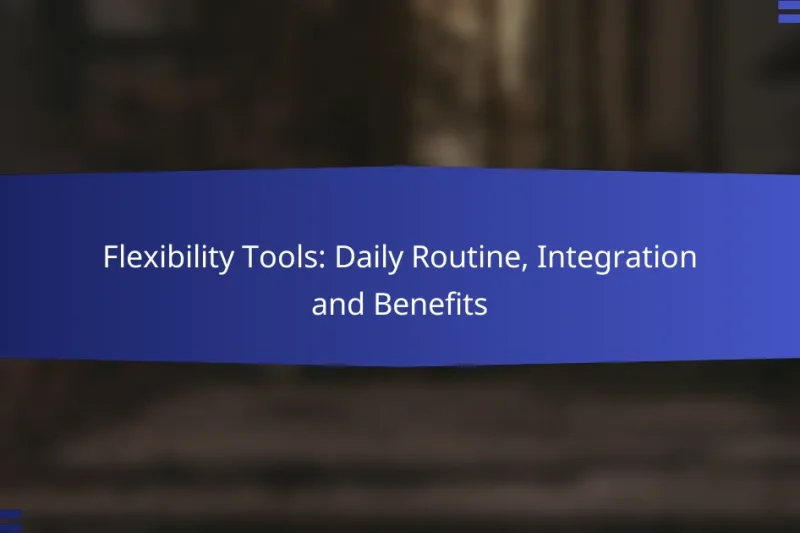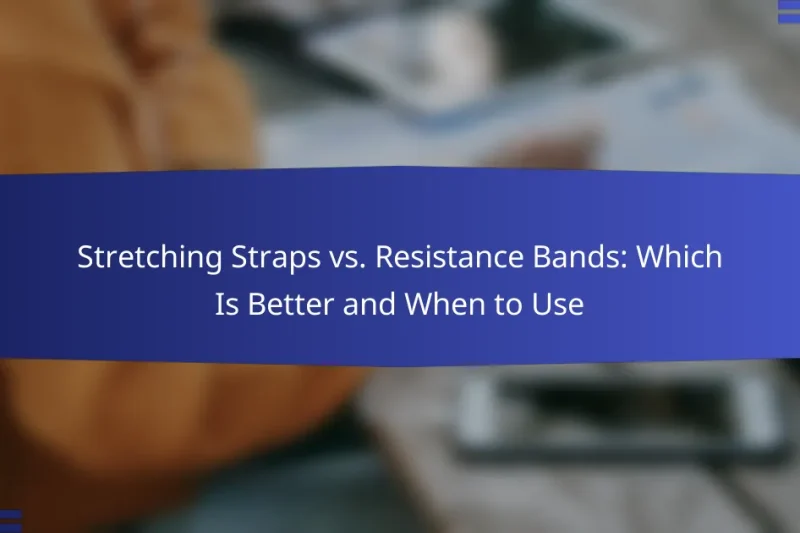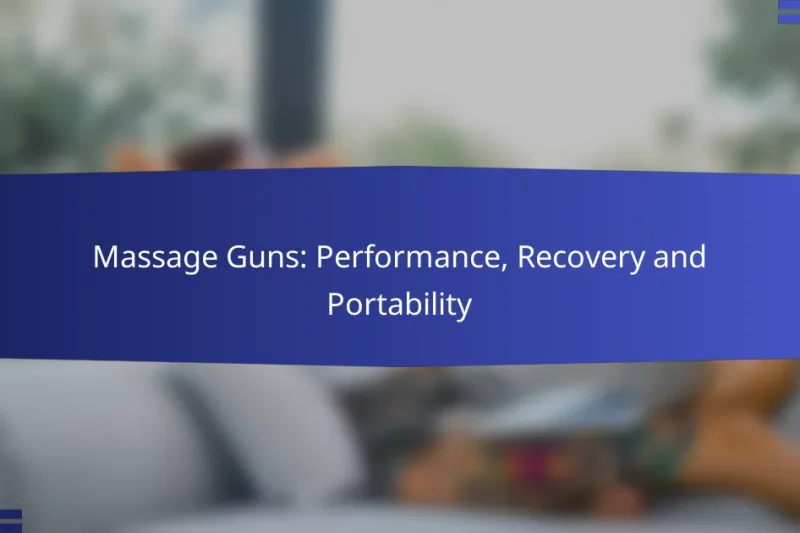Stability balls are versatile fitness tools that engage multiple muscle groups, particularly the core, while promoting … Stability Balls: User Reviews, Benefits and VersatilityRead more
Flexibility and Recovery Tools
Flexibility and recovery tools are essential for athletes looking to enhance their performance and reduce the risk of injury. By incorporating items like foam rollers, resistance bands, and massage guns into their routines, athletes can improve mobility, alleviate muscle soreness, and promote quicker recovery after intense training sessions. Leading brands such as TriggerPoint and Theragun offer innovative solutions tailored to meet these needs.
Flexibility Tools: Daily Routine, Integration and Benefits
Flexibility tools play a crucial role in enhancing daily routines by enabling individuals to tailor their … Flexibility Tools: Daily Routine, Integration and BenefitsRead more
Stretching Straps vs. Resistance Bands: Which Is Better and When to Use
When it comes to enhancing your fitness routine, understanding the differences between stretching straps and resistance … Stretching Straps vs. Resistance Bands: Which Is Better and When to UseRead more
Massage Guns: Performance, Recovery and Portability
Massage guns are innovative tools designed to enhance athletic performance by promoting recovery and increasing blood … Massage Guns: Performance, Recovery and PortabilityRead more
Foam Rollers: Muscle Recovery, Pain Relief and Flexibility
Foam rollers are essential tools for muscle recovery, offering benefits such as improved blood circulation, reduced … Foam Rollers: Muscle Recovery, Pain Relief and FlexibilityRead more
Flexibility Accessories: Tools, Techniques and Benefits
Flexibility accessories, such as yoga mats, resistance bands, and foam rollers, play a crucial role in … Flexibility Accessories: Tools, Techniques and BenefitsRead more
Yoga Mats: Comfort, Grip and Durability
Choosing the right yoga mat is essential for enhancing your practice, as it impacts comfort, grip, … Yoga Mats: Comfort, Grip and DurabilityRead more
What are the best flexibility and recovery tools for athletes?
The best flexibility and recovery tools for athletes include foam rollers, resistance bands, massage guns, stretching straps, and yoga mats. These tools help improve mobility, reduce muscle soreness, and enhance overall recovery after intense training sessions.
Foam rollers
Foam rollers are cylindrical tools used for self-myofascial release, which helps alleviate muscle tightness and improve blood flow. Athletes can use them on various muscle groups, focusing on areas that feel particularly sore or tense.
When using a foam roller, apply pressure slowly and roll over the targeted area for about 30 seconds to 2 minutes. Avoid rolling directly over joints or bones, and listen to your body to prevent excessive discomfort.
Resistance bands
Resistance bands are versatile tools that can enhance flexibility and strength through various stretching exercises. They come in different resistance levels, allowing athletes to gradually increase intensity as they progress.
To use resistance bands effectively, anchor them to a stable object or hold them in your hands while performing stretches. Incorporate movements that target specific muscle groups, and aim for 10-15 repetitions for each exercise.
Massage guns
Massage guns are handheld devices that deliver rapid bursts of pressure to muscle tissue, promoting relaxation and recovery. They can be particularly effective for relieving soreness and stiffness after workouts.
When using a massage gun, start with a low setting and gradually increase intensity as needed. Spend about 1-2 minutes on each muscle group, avoiding bony areas and focusing on sore spots for optimal results.
Stretching straps
Stretching straps are tools designed to assist with deeper stretches and improve flexibility. They help athletes maintain proper form while stretching, making it easier to reach and hold positions that may be challenging otherwise.
To use a stretching strap, loop it around your foot or a stable object and gently pull to deepen the stretch. Hold each stretch for 20-30 seconds, and breathe deeply to enhance relaxation and effectiveness.
Yoga mats
Yoga mats provide a stable and comfortable surface for stretching and recovery exercises. They offer cushioning and grip, which can enhance safety and effectiveness during workouts.
When selecting a yoga mat, consider thickness and material for comfort and durability. Use the mat for various flexibility exercises, ensuring it is clean and dry to prevent slipping during practice.
How do flexibility and recovery tools enhance performance?
Flexibility and recovery tools significantly enhance athletic performance by improving movement efficiency and reducing the risk of injury. These tools help athletes maintain optimal muscle function, allowing for better training outcomes and quicker recovery after intense workouts.
Improved range of motion
Flexibility tools such as foam rollers, resistance bands, and stretching devices help increase the range of motion in joints and muscles. A greater range of motion allows athletes to perform movements more effectively, which can lead to improved technique and performance in their respective sports.
Incorporating dynamic stretching before workouts and static stretching afterward can enhance flexibility. Aim for at least 10-15 minutes of stretching to see noticeable improvements over time.
Reduced muscle soreness
Recovery tools like massage guns and compression garments can significantly reduce muscle soreness after workouts. These tools promote blood circulation and help flush out metabolic waste, which contributes to soreness.
Using these tools within 30 minutes post-exercise can maximize their effectiveness. Regular use can lead to a noticeable decrease in delayed onset muscle soreness (DOMS), allowing athletes to train more consistently.
Faster recovery times
Flexibility and recovery tools facilitate faster recovery times by aiding in muscle repair and reducing fatigue. Techniques such as active recovery, utilizing foam rollers, and engaging in low-intensity activities can enhance recovery processes.
For optimal results, consider implementing a structured recovery routine that includes hydration, nutrition, and adequate rest. This holistic approach can cut recovery times significantly, enabling athletes to return to peak performance levels more quickly.
What are the top brands for flexibility and recovery tools?
The leading brands for flexibility and recovery tools include TriggerPoint, Theragun, ProForm, and Hyperice. Each brand offers unique products designed to enhance muscle recovery, improve flexibility, and reduce soreness.
TriggerPoint
TriggerPoint specializes in foam rollers and massage balls that target specific muscle groups to relieve tension. Their products are designed to mimic the techniques used by massage therapists, making them effective for self-myofascial release.
When using TriggerPoint tools, focus on areas of tightness and apply pressure for 30 seconds to a minute. This can help improve blood flow and flexibility. Consider incorporating their tools into your routine after workouts or during recovery days.
Theragun
Theragun is known for its percussive therapy devices that deliver rapid bursts of pressure to sore muscles. These devices can help alleviate pain, improve circulation, and enhance range of motion.
For optimal results, use the Theragun on muscle groups that feel tight or fatigued, spending about 30 seconds on each area. The adjustable speed settings allow you to customize the intensity based on your comfort level. Regular use can significantly aid in recovery and flexibility improvement.
ProForm
ProForm offers a range of fitness equipment, including recovery tools like foam rollers and massage guns. Their products are designed to complement workout routines and promote muscle recovery.
Using ProForm tools can be beneficial after intense exercise sessions. Aim to spend a few minutes on each muscle group, focusing on areas that feel particularly sore. This practice can help reduce muscle stiffness and enhance overall flexibility.
Hyperice
Hyperice is recognized for its innovative recovery technology, including vibration therapy devices and ice compression systems. Their tools are designed to accelerate recovery and improve mobility.
Incorporating Hyperice products into your routine can be particularly effective post-workout. For instance, using their vibration devices for 15-30 seconds on sore muscles can enhance recovery. Additionally, their ice compression systems can help reduce inflammation and speed up healing after intense physical activity.
How to choose the right flexibility and recovery tool?
Choosing the right flexibility and recovery tool involves understanding your specific needs and preferences. Consider factors such as your fitness goals, the effectiveness of the tool, and how easy it is to transport and store.
Consider your fitness goals
Your fitness goals play a crucial role in selecting the appropriate flexibility and recovery tool. For instance, if your aim is to improve overall flexibility, tools like foam rollers or resistance bands may be beneficial. Conversely, if recovery from intense workouts is your priority, options such as massage guns or compression sleeves could be more suitable.
Identify whether you need a tool for warm-ups, cool-downs, or injury prevention. This clarity will help you narrow down your choices effectively.
Evaluate tool effectiveness
Assessing the effectiveness of flexibility and recovery tools is essential for achieving desired results. Research user reviews and expert recommendations to gauge how well a tool performs its intended function. For example, foam rollers are widely recognized for alleviating muscle soreness and improving blood flow.
Consider trying out different tools to see which ones provide the best relief and results for your body. Many gyms offer a variety of equipment, allowing you to test before committing to a purchase.
Assess portability and storage
Portability and storage are important factors when selecting flexibility and recovery tools, especially for those who travel or have limited space. Lightweight and compact options, such as resistance bands or travel-sized foam rollers, can easily fit into a gym bag or suitcase.
Evaluate your living situation and workout environment to determine how much space you can allocate for storage. Tools that can be easily stored away or have multi-functional uses can enhance convenience and efficiency.
What are the benefits of using foam rollers?
Foam rollers provide several benefits, primarily aiding in muscle recovery and enhancing flexibility. They are effective tools for self-myofascial release, which can alleviate muscle tightness and improve overall performance.
Myofascial release
Myofascial release is a technique that targets the fascia, the connective tissue surrounding muscles. Using a foam roller helps to break down knots and tension in the fascia, which can lead to improved mobility and reduced pain. Regular use can be particularly beneficial after intense workouts or prolonged periods of inactivity.
To effectively perform myofascial release, roll slowly over tight areas for 30 seconds to a minute, allowing the pressure to help release tension. Focus on major muscle groups such as the back, thighs, and calves for optimal results.
Increased blood flow
Foam rolling stimulates circulation, which increases blood flow to the muscles. Improved blood flow enhances nutrient delivery and waste removal, promoting faster recovery after exercise. This is especially important for athletes or those engaging in regular physical activity.
For best results, incorporate foam rolling into your warm-up or cool-down routine. Aim for 5-10 minutes of rolling to effectively boost circulation and prepare your muscles for activity or aid in recovery afterward.
Improved muscle elasticity
Foam rollers can enhance muscle elasticity by stretching and lengthening muscle fibers. This increased elasticity can lead to better overall performance and a lower risk of injury during physical activities. Regular foam rolling can help maintain flexibility, especially as muscles tend to tighten with age or inactivity.
To improve muscle elasticity, focus on rolling each muscle group for 1-2 minutes, ensuring that you cover the entire length of the muscle. Combine foam rolling with static stretching for a comprehensive flexibility routine.
How often should you use recovery tools?
Recovery tools should be used regularly, ideally after intense workouts or physical activities. Incorporating these tools into your routine can enhance muscle recovery and reduce soreness.
Types of recovery tools
Recovery tools come in various forms, including foam rollers, massage guns, compression garments, and ice packs. Each type serves a different purpose; for instance, foam rollers help relieve muscle tightness, while massage guns can target specific areas for deeper tissue relief.
When selecting recovery tools, consider your specific needs and preferences. For example, if you experience chronic muscle soreness, a massage gun may be more effective than a foam roller. It’s also beneficial to have a mix of tools to address different recovery aspects.
When to use recovery tools
Timing is crucial when using recovery tools. Ideally, they should be used immediately after workouts or physical activities to maximize their effectiveness. Additionally, incorporating them into your routine on rest days can help maintain muscle flexibility and prevent stiffness.
For optimal results, aim to use recovery tools for about 10-20 minutes per session. This duration allows for sufficient time to target sore areas without overdoing it. Listen to your body and adjust the frequency based on your recovery needs.
Benefits of regular use
Regular use of recovery tools can lead to improved flexibility, reduced muscle soreness, and enhanced overall performance. By promoting blood flow and reducing tension, these tools help your body recover more efficiently.
Incorporating recovery tools into your routine can also prevent injuries. By maintaining muscle elasticity and reducing tightness, you can lower the risk of strains and sprains during physical activities. Aim for a consistent routine to reap these benefits fully.






